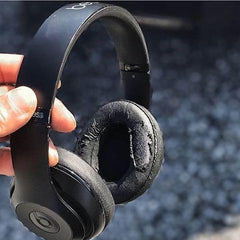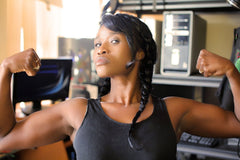Halo Sport Headphones: Neuropriming Your Workout

With the Halo Sport 2 headphones about to be released, we thought we’d take a closer look at what neuropriming your workout actually means and whether or not using neuroscience to improve your fitness and form is ethical and safe.
What is Neuropriming?
Neuropriming is when small electrical pulses are passed into the brain’s motor cortex via transcranial direct-current stimulation (tDCS) putting the brain into a state known as ‘hyperlearning’.
In this hyperlearning state, the brain is encouraged to create more neural pathways temporarily making the body more receptive to physical activity.
This electrical stimulation of the brain is done via helmets, headsets and now via headphones.
Neuropriming doesn’t only have its uses on the track or in the gym. If you’re learning to play an instrument or to speak a foreign language, then it can help with those, too. In the United States, it’s being applied to military training — pilots, snipers, soldiers, anyone who has to make quick decisions in the field. tDCS can help individuals make clearer and more rational decisions.
And there’s the potential that it could be used to help treat depression and anxiety.
Halo Neuroscience — the company behind the Sport headphones — say that it doesn’t matter whether you’re trying to improve your mental or physical form as it all happens via the same process: through the brain’s motor cortex.What Are Halo Sport Headphones and How Do They Neuroprime Your Workout?
Halo Neuroscience released the Halo Sport Headphones back in 2017. Neuro-stimulation technology could be the next big thing in sports performance — neurotechnology products could become worth more than $3 billion by 2020.
The Halo Sport 2 is set to be released in June 2019 with a current retail price of $299 (£230).
Halo Sport has some big customers: teams in both the NBA and NFL have used its headphones in training. The ReadWrite website reports how the US Olympic Ski and Snowboarding teams have seen an increase in performance since using Halo Sport.
CEO of Halo Neuroscience, Dr Daniel Chao, explains that at the elite athlete level there’s really not much of difference between athletes who come 1st and those who come 20th. In most cases, the winner has an edge over the competition — that’s all. For top-level athletes as well as for everyday consumers of performance-improving tech, the chance to train and improve beyond current endurance levels is, understandably, very tempting
Jeff Bercovici writing in Men’s Health Magazine points out that it means athletes can spend less time practising to reach the top-level. You can see why the military is interested in this type of technology, too — reducing the number of hours to train someone to a professional level means a better investment and fewer pounds and dollars spent per person.
If you’ve ever struggled to learn piano chords or how to drive a car, fly an aeroplane or pass advanced calculus, then it could push you beyond whatever learning barriers your brain has put in front of you.
Halo 2 also helps reduce fatigue meaning wearers can practice at higher rates of learning for longer.

Beginning the Neuropriming Sequence
Over-ear and available for both iOS and Android, the Halo 2 allows users to pick the focus of each workout: arms, legs etc before the neuropriming begins.
Primers are small teeth which stick out from beneath the headphone’s headband providing contact with the scalp. Before beginning a workout, users should spray these primers with water to aid connection as this helps the electric pulses to pass into the brain. The headphones can be controlled through your phone and it’s recommended that you wear them twenty minutes before starting your workout. Once the sequence is done, you can continue to listen to music in the headphones as normal.
Wearers can begin a light warmup during the neuropriming sequence.
Those who wear the headphones describe feeling a slight tingling but say that it isn’t unpleasant or painful but can take some getting used to.
You can amp up the intensity.
Although, interestingly, Halo Neuroscience says that the neuropriming sequence works the same at whatever level you use it at.
Are They Good Headphones for Listening to Music?
If you’re buying the Halo Sport 2 headphones, then you’re probably not buying them for sound quality; you’re buying them for the neuropriming. Reviews for the general use of the headphones have been positive, however.
Digital Trends writes that the Halo Sport headphones have a good weight to them — lightweight to wear but with some heaviness when you hold them. It comes with pre-fixed open-cups but if you want more sound isolation then these can be swapped for closed-cups included in the box. Digital Trends goes on to suggest that a single charge should last for around 8 neuropriming sessions. There are no wireless options for listening to music but the sound quality has been reported as good.
Is it Ethical For Elite Athletes to Neuroprime Their Workouts?
We’re quite used to seeing athletes being reprimanded for using performance-enhancing drugs but what about performance-enhancing neuroscience? Is it something that the World Doping Agency (WADA) should be concerned about or is it no different to boosting athletic performance with music?
As The Conversation.com notes, tDCS is not currently banned by WADA. You can’t test if someone has used tDCS because it doesn’t leave behind a physical trace as a drug does. Which begs the question of how it can be policed.
Are Halo Sport Headphones Safe to Use?
The terminology used by Halo Neuroscience can sound daunting: electrodes, primers, motor cortex, neuropriming…
It doesn’t help, either, that Halo Neuroscience has the kind of name Hollywood writers give to big-bad corporations SO it’s understandable that some people are concerned about what the long-term effects of electrical brain stimulation will be.
There’s a ton of scientific studies to support Halo Neuroscience’s assurances that not only do the headphones work but that they’re completely safe, too. The problem is a lack of published papers available for peer review in scientific journals.
tDCS itself does have scientific research to back up that it works and that it’s safe but these are relatively short-term.
Speaking to Men’s Health magazine, Andy McKinley, Ph.D., chief of the cognitive--performance optimization section of the U. S. Air Force’s applied-neuroscience branch, said that “The safety record of tDCS is exceptional,”
But not everyone is sold.
Queen's University Prof. Gunnar Blohm told the CBC news website that he wouldn’t recommend using tDCS for improved performance. He went on to say:
"We know that the actual structure of the brain gets changed in a long-lasting fashion. So if you're now applying tDCS, like, uncontrolled to your own brain, what are you actually doing to yourself?"
The problem is that whilst tDCS and neuropriming appear to improve performance, the technology is a relatively recent development without enough time for thorough long term studies into its effects.
The proof of the pudding will be in the wearing and for most elite athletes, professional and customers the results seem worth the risk.
It’ll be interesting to see how the release of the Halo 2 goes and whether neuropriming your workout will be something we’re prepared to do in the coming years. For now, however, despite how intriguing it all sounds, we’re sticking to workouts in our regular old headphones paired with sweat-proof headphone covers.
Let us know in the comments whether or not you’re tempted by brain-boosting sports technology.







